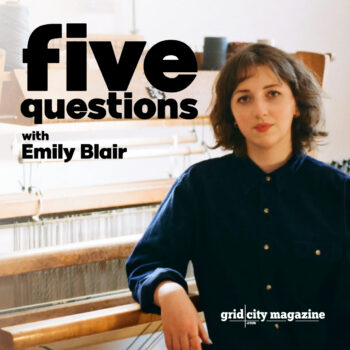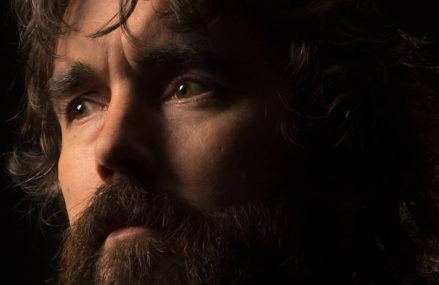Weaver and cultural worker Emily Blair is the Artistic Director of Connexion ARC, Fredericton’s only artist-run centre.
 Matt Carter
Matt Carter
In August, weaver and cultural worker Emily Blair was announced as the new Artistic Director of Connexion ARC, Fredericton’s only artist-run centre. She is a graduate of the New Brunswick College of Craft and Design and holds a Bachelor of Fine Arts with Distinction from Concordia University, majoring in Fibre and Materials Practice with a minor Art History. While living in Montreal, Emily worked closely with the artist-run-centers Art Matters Festival as their Administrative Coordinator, the VAV Gallery in Administration and curation, and the Fine Art Student Alliance as a Community Organizer, and served on several arts organization boards.
As Connexion ARC prepares to celebrate its 40th anniversary in 2024, we spoke with Emily to learn more about her new position and the important role artist-run centres play in supporting and championing the work of contemporary artists.
First off, let’s talk about artist-run centres. How would you describe an ARC to someone unfamiliar, but also curious?
An artist-run centre is a space run by and for artists to grow a community of support and connection. I believe ARCs occupy a really exciting space of de-commercialized art practices where an ARC’s focus should be on paying artists as its top priority to allow for full creative exploration and collaboration. Many ARCs are non-profit organizations with a mandate of community driven projects that focus on engagement and experimentation and for funding to go directly back into the community while events are kept financially accessible. I feel non-profit artist run centers can be sites of redefining networking and sharing in each other’s success.
Fredericton has seen a lot of different versions of Connexion over the years. Each new director brings new purpose and new ideas. Starting small, what are some things you’d like to achieve over the coming year?
With so many years behind it, I have the privilege of being able to look back on many iterations of programming, projects and the ebb and flow of our membership and I am so excited to be organizing the 40th anniversary programming this coming year! There are definitely projects I would like to achieve beyond this. I am very eager to reassess what it means to be a Connexion member. I want to see this expanded. I want to see our collaborations grow, I want to create more intercity and interprovincial collaboration from Connexion and I want to tap into how best we can contribute to our local and incredibly active community as well. I am also very excited to begin rolling out an annual schedule of events.
You have a wealth of experience working in ARCs during your time in Montreal. From your experience, how do different organizations balance artist development and public engagement?
I think the balance needs to come from remembering that arts organizations serve their membership first. Public engagement is essential to the growth of an organization and in showcasing the work of its members, but times where I’ve seen the balance be thrown off is when an organization places the needs of its community, including the staff that work to maintain the programming of the organization, behind things like public perception or personal accolades in the public setting. But I absolutely believe that the development of artists is fostered in a reciprocal dialogue with the public that hopefully will grow and improve if programming is done with the priority of its membership in mind.
Administration duties aside, and speaking entirely as an artist here, what’s one of the biggest ways your own practice has benefited through your involvement in an ARC?
I think the whole idea around an artist run centre is that being run by artists grants the organization insight into the perspective of being a showcasing artist. I have found it to be hugely helpful to be the one receiving contracts, waiting on payment, packing and shipping my work and noticing the difference when I feel supported by an organization and when I don’t. I think this is the biggest benefit in being an artist working in an ARC, it feels very personal to advocate for the financial support of artists.
Fredericton’s contemporary art community has never really got the same exposure as, say, the music community. I’m sure that has a lot to do with accessibility and familiarity. That said, Flourish has been an incredible event for exposing people to new forms of art, or just art they may not otherwise come into contact with. But a lot of the festival’s programming happens in bars which is really limiting to an audience. And it’s only once a year. As someone living here and now running an ARC, where does contemporary art fit into our community the other 51 weeks of the year?
I completely agree that Flourish has been absolutely amazing in their efforts to foster contemporary art alongside the active music community in Fredericton. I think this same energy and mandate apply throughout the year as well! Though there is not always the time, energy or space for some of the classic ways we experience contemporary art, like vernissages and performance events, I think there are many other underrated ways to nurture community and care for each other. Contemporary art spaces can undertake many efforts like developing studios and equipment access, bringing in networking and knowledge sharing events, food sharing as an act of care, and maintaining active conversations around accessibility and inclusivity and how that shapes our work.
Related: Five Questions with Jesse Bush
Related: Five Questions with Abigail Smith




